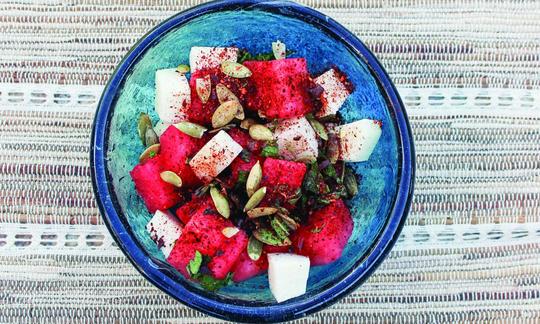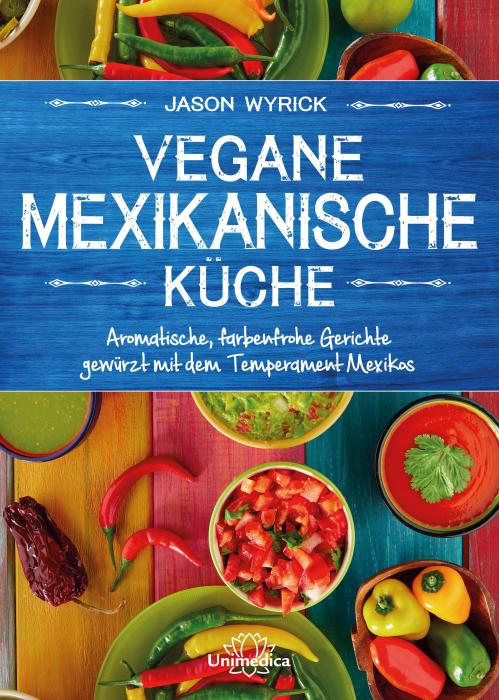Watermelon Jicama Salad
raw-vegan
Ingredients (for servings, )
| For the salad | |
|---|---|
| 8 ½ oz | Watermelons, raw (organic?) |
| 9 ½ oz | Yam beans (tuber bean, jícama, benkuang), raw, organic? |
| For the dressing | |
| 2 | Limes, raw (organic?) (4.7 oz) |
| 3 tbsp | Pumpkin seeds, roasted, without salt (pumpkin seeds) (1.1 oz) |
| 1 tbsp | Moroccan mint, raw (organic?) (0.20 oz) |
| 1 tbsp | Chili powder (raw?, organic?) (0.28 oz) |
| ⅓ tsp | Sea salt (raw?, organic?) (0.06 oz) |
Equipment
- vegetable peeler
- citrus juicer (lemon squeezer)
Type of preparation
- chop or grind
- food preparation without heating
- squeeze
- meld
- peel
Preparation
For the salad
Dice the watermelon. Peel the jicama and cut into ½-inch cubes.Alternatively, you can replace the jicama with 350 g peeled and deseeded cucumber for four servings.
For the dressing
Squeeze the lime and mince the mint. Combine the lime juice, pumpkin seeds, minced mint, chili powder, and salt in a bowl. Add the watermelon and jicama and let the salad sit for 5 minutes.The author uses guajillo chili powder and suggests adding ½ teaspoon pequín chili powder (for four servings) if you would like the dish to be spicier.
Serving
Serve fresh, after you have let the salad sit for 5 minutes.
|
Nutritional Information per person
Convert per 100g
|
2000 kcal | |
|---|---|---|
| Energy | 104 kcal | 5.2% |
| Fat/Lipids | 4.2 g | 6.0% |
| Saturated Fats | 0.72 g | 3.6% |
| Carbohydrates (inc.dietary fiber) | 16 g | 6.1% |
| Sugars | 5.9 g | 6.6% |
| Fiber | 5.8 g | 23.1% |
| Protein/Albumin | 3.7 g | 7.3% |
| Cooking Salt (Na:221.3 mg) | 562 mg | 23.4% |
| Essential micronutrients with the highest proportions | per person | 2000 kcal | |
|---|---|---|---|
| Vit | Vitamin C (ascorbic acid) | 29 mg | 36.0% |
| Sodium, Na | 221 mg | 28.0% | |
| Min | Manganese, Mn | 0.45 mg | 23.0% |
| Min | Copper, Cu | 0.20 mg | 20.0% |
| Prot | Tryptophan (Trp, W) | 0.05 g | 20.0% |
| Elem | Phosphorus, P | 120 mg | 17.0% |
| Fat | Linoleic acid; LA; 18:2 omega-6 | 1.7 g | 17.0% |
| Elem | Magnesium, Mg | 62 mg | 16.0% |
| Elem | Potassium, K | 310 mg | 16.0% |
| Min | Iron, Fe | 1.9 mg | 13.0% |
Detailed Nutritional Information per Person for this Recipe
The majority of the nutritional information comes from the USDA (US Department of Agriculture). This means that the information for natural products is often incomplete or only given within broader categories, whereas in most cases products made from these have more complete information displayed.
If we take flaxseed, for example, the important essential amino acid ALA (omega-3) is only included in an overarching category whereas for flaxseed oil ALA is listed specifically. In time, we will be able to change this, but it will require a lot of work. An “i” appears behind ingredients that have been adjusted and an explanation appears when you hover over this symbol.
For Erb Muesli, the original calculations resulted in 48 % of the daily requirement of ALA — but with the correction, we see that the muesli actually covers >100 % of the necessary recommendation for the omega-3 fatty acid ALA. Our goal is to eventually be able to compare the nutritional value of our recipes with those that are used in conventional western lifestyles.
| Essential fatty acids | per person | 2000 kcal |
|---|---|---|
| Linoleic acid; LA; 18:2 omega-6 | 1.7 g | 17.0% |
| Alpha-Linolenic acid; ALA; 18:3 omega-3 | 0.04 g | 2.0% |
| Essential amino acids | per person | 2000 kcal |
|---|---|---|
| Tryptophan (Trp, W) | 0.05 g | 20.0% |
| Threonine (Thr, T, irreversibly transaminated) | 0.11 g | 12.0% |
| Isoleucine (Ile, I) | 0.13 g | 10.0% |
| Phenylalanine (Phe, F) | 0.16 g | 10.0% |
| Valin (Val, V) | 0.16 g | 10.0% |
| Leucine (Leu, L) | 0.22 g | 9.0% |
| Lysine (Lys, K, irreversibly transaminated) | 0.16 g | 9.0% |
| Methionine (Met, M) | 0.06 g | 6.0% |
| Vitamins | per person | 2000 kcal |
|---|---|---|
| Vitamin C (ascorbic acid) | 29 mg | 36.0% |
| Vitamin E, as a-TEs | 1.2 mg | 10.0% |
| Vitamin B6 (pyridoxine) | 0.12 mg | 9.0% |
| Vitamin B9, B11 (Folate, as the active form of folic acid) | 19 µg | 9.0% |
| Vitamin B3 (Niacin) | 0.89 mg | 6.0% |
| Vitamin B5 (Pantothenic acid) | 0.37 mg | 6.0% |
| Vitamin A, as RAE | 51 µg | 6.0% |
| Vitamin B1 (Thiamine) | 0.06 mg | 5.0% |
| Vitamin B2 (Riboflavin) | 0.07 mg | 5.0% |
| Vitamin K | 2.9 µg | 4.0% |
| Vitamin B7 (Biotin, ex vitamin H) | 0.38 µg | 1.0% |
| Essential macroelements (macronutrients) | per person | 2000 kcal |
|---|---|---|
| Sodium, Na | 221 mg | 28.0% |
| Phosphorus, P | 120 mg | 17.0% |
| Magnesium, Mg | 62 mg | 16.0% |
| Potassium, K | 310 mg | 16.0% |
| Calcium, Ca | 37 mg | 5.0% |
| Essential trace elements (micronutrients) | per person | 2000 kcal |
|---|---|---|
| Manganese, Mn | 0.45 mg | 23.0% |
| Copper, Cu | 0.20 mg | 20.0% |
| Iron, Fe | 1.9 mg | 13.0% |
| Zinc, Zn | 0.88 mg | 9.0% |
| Selenium, Se | 2.0 µg | 4.0% |
| Fluorine, F | 2.9 µg | < 0.1% |
| Iod, I (Jod, J) | 0.62 µg | < 0.1% |
Narayana Verlag GmbH /Unimedica Verlag , Jason Wyrick
Raw recipes 21 (1), Cooked recipes 117 (3)
Additional photos (4)
"Vegan Mexican Cuisine – Aromatic, colorful dishes seasoned with the temperament of Mexico" provides a comprehensive insight into Mexican cuisine.
Since this book is written in German, a description is omitted here. If you are interested, please switch to German in the menu.
This watermelon jicama salad with pumpkin seeds, mint, and chili peppers is refreshing and spicy. It’s easy to make and only takes a few minutes to prepare.
Jicama: Jicama, also called Mexican yam bean or Mexican turnip, is naturally found in Mexico as well as in countries in Central and South America, but it was brought to Asia several centuries ago. The plant contains very little protein or fat and only the root can be eaten raw. Jicama has a consistency similar to that of radishes, ranging from slightly woody to juicy. They have a sweet flavor that is reminiscent of apples. Jicama may be confused with yams: bare in mind that yams are a completely different vegetable and most yam varieties cannot be eaten raw.
Watermelon: Watermelons are low in calories and are 90 % water. They have a sweet, refreshing flavor and are ideal for hot days. Some watermelons weigh up to 100 kg; however, most weigh between 4 and 25 kg. They can be stored for 2–3 weeks at temperatures of 12–15 °C and 85–90 % humidity.
Cucumbers: If you can’t find Jicama, the author Jason Wyrick suggests using 350 grams of peeled and deseeded cucumber for four servings. However, cucumbers have a considerably different flavor than jicama.
Chili powder: The original recipe uses guajillo chili powder, which is made from mirasol chili and has a fruity flavor. If you want your salad to be a bit hotter, you can add pequin chili powder, which measures up to 100,000 SHU (Scoville Heat Units).




